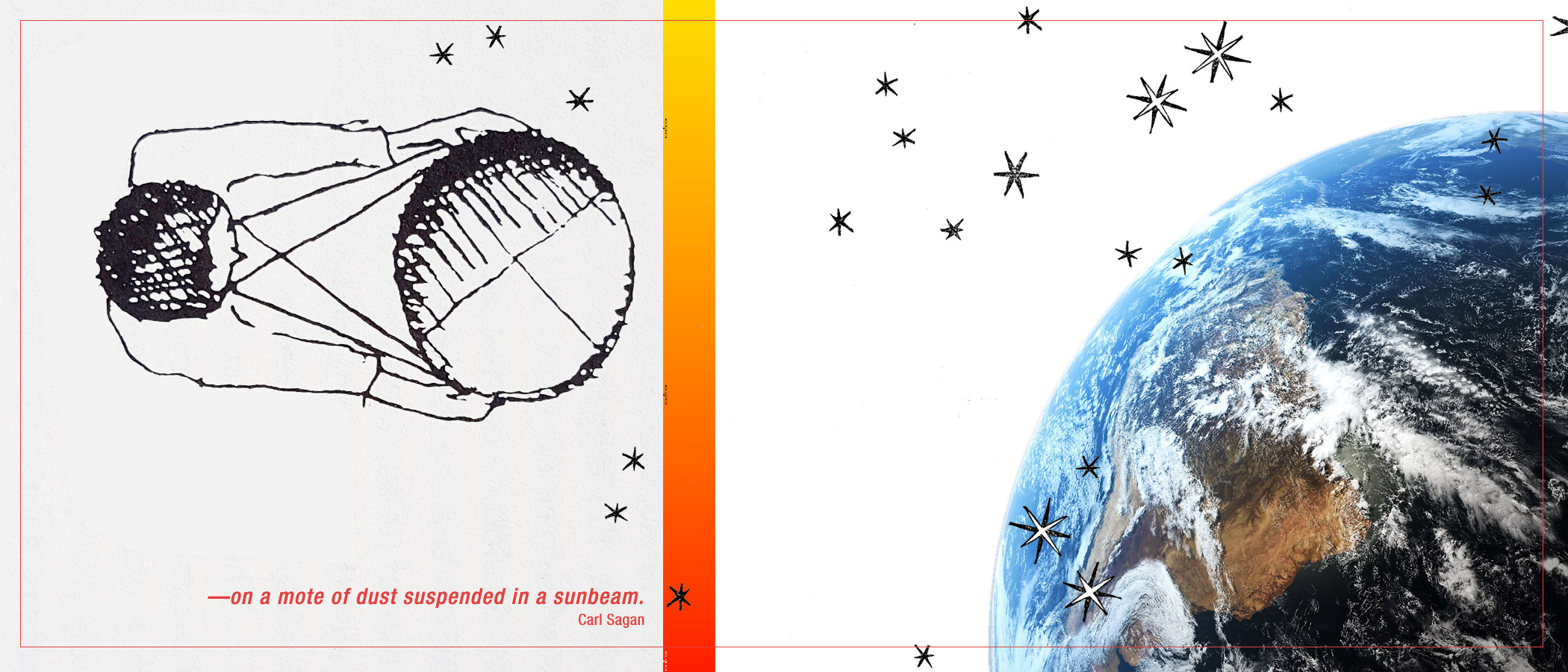
Pale Blue Dot
The value of a single pixel
February 10, 2020 · Nanosat Team
First ever tour, and portrait, of the Solar System, 20th century. The Voyager deep space probe sends an intriguing image, even disturbing. In it, with an apparent size only 0.12 pixel, is the Earth.

The most remote photography of our planet until today, from a record distance of about 6 billion kilometers. Voyager 1 cameras taked The Solar System Family Portrait on February 14, 1990, by looking back and photographing on every planet in the solar system. It was the first ever "portrait" of our Solar System as seen from the outside. Astronomer Carl Sagan, main designer of the mission, had been working for a decade to get these pictures taken. Himself converted the faint image of Earth in one of the most iconic images of the human culture, by naming it The Pale Blue Dot. “Look again at that dot. That's here. That's home.” The Carl Sagan's video insightful, deep and moving about this image is a must-see! Inspired by the image, Sagan wrote the book Pale Blue Dot: A Vision of the Human Future in Space. As Wikipedia summarizes, “In this book, Sagan mixes philosophy about the human place in the universe with a description of the current knowledge about the Solar System. He also details a human vision for the future (…) future exploration of space should focus on ways to protect Earth and to extend human habitation beyond it.”
Earth is our only habitable home
The 30th anniversary of this symbolic photo of Earth is an event that deserves to be remembered, celebrated and put in perspective, in light of the current challenges for humanity. This has been understood by NASA and the IAU with their respective initiatives that should be used to open a global debate.
NASA Jet Propulsion Laboratory organized on Feb. 7, 2020 the public talk Beyond the Pale Blue Dot: Seeing Distant Planets “for a discussion about perspective: the value of what a single pixel can tell us and what it can make us feel. We’ll look at the impact of that image and other distant views of Earth. We'll then turn to the quest to photograph another Earth — an exoplanet orbiting another star — as its own pale blue dot.”
The International Astronomical Union (IAU) organize the Pale Blue Dot global astronomy education initiative, with activities between 13-20 February 2020, around the topics of global citizenship, open-mindedness to other cultures and and environmental awareness to inspire children and broaden their perspective. “The Pale Blue Dot global project intends to facilitate event organizers to use astronomy as a tool to initiate conversations in their respective communities about global citizenship and uniting people from all cultures and backgrounds. Furthermore, this initiative aims to inform audiences about climate change by using the perspective of astronomy to remind the public that the Earth is our only habitable home.”
Our “worldview”
The greatness and transcendence of this image resides in the extreme smallness, the frailty, the vulnerability, and the isolation in the vastness of universe, that transmits an Earth converted into little more than “a mote of dust suspended in a sunbeam.” Sagan make us think and moves us when he concludes “Look again at that dot. That's here. That's home. That's us. On it everyone you love, everyone you know, everyone you ever heard of, every human being who ever was, lived out their lives. The aggregate of our joy and suffering, thousands of confident religions, ideologies, and economic doctrines, every hunter and forager, every hero and coward, every creator and destroyer of civilization, every king and peasant, every young couple in love, every mother and father, hopeful child, inventor and explorer, every teacher of morals, every corrupt politician, every "superstar," every "supreme leader," every saint and sinner in the history of our species lived there--on a mote of dust suspended in a sunbeam.”

From the beginning of the space age in 1957, satellites introduced a new point of view in our lives. But it will be with crewed flights since the sixties when the experience of astronauts watching the Earth from outer space arouses a space euphoria, a perspective-altering experience, a feeling of cosmic connection, in short a new personal and collective consciousness. We talk about the Overview Effect. The expression and its connotations were devised in Frank White's book, The Overview Effect: Space Exploration and Human Evolution, a seminal work in space philosophy. Frank White realizes that “mental processes and views of life cannot be separated from physical location. Our “worldview” as a conceptual framework depends quite literally on our view of the world from a physical place in the universe.”
A global vision of our home: Earth
“White found that astronauts know from direct experience what the rest of us know only intellectually: we live on a planet that is like a natural spaceship moving through the universe at a high rate of speed. We are, in fact, the crew of “Spaceship Earth,” as Buckminster Fuller described our world.” Among many other initiatives to explore and foster this planetary consciousness, it was created The Overview Institute: “At this critical moment, our greatest need is for a global vision of planetary unity and purpose for humanity as a whole.”
The NASA astronaut Christina Koch, has spent almost a year on the International Space Station – the first woman in doing so –. Last week, just before come back home, the Earth, she confirmed vividly this vision: “Earth is alive, and I have witnessed its power and beauty from a special vantage point 250 miles above the surface. From the space station we see no borders, no boundaries – we are all part of one giant organism that breathes and adapts. I have been in awe of this perspective for almost a year now.”

In the profile of our twitter account, this shared overview of our beloved and threatened Spaceship Earth, is summarized so “2020’s a make-or-break time: Spacefaring Civilisation for the Human Species.” Everyone compromised with a sustainable and thriving future for humanity can contribute to make a positive change in this challenging and decisive times. Space technologies play a central role in climate change monitoring, weather forecasting, disaster management, search and rescue operations… More generally, space can be used in support of the 2030 Agenda for Sustainable Development, developed by the United Nations to face the societal challenges that need to be overcome to enhance human development (#Space4SDGs). And space professionals, but also space amateurs, have a special role in the design and operation of this spacecrafts that made possible an accurate and efective monitoring of the green house gases, the evolution of climate, and the growing extreme weather events. The data collected by satellites are key in the management of disasters caused by climate change, among many other things.
A new generation of Earth observation and space technologies are being tested and implemented using the potential of nanosatellites, specially of the CubeSats, with projects like Phoenix, TEMPEST-D, RAVAN, MethaneSAT, RainCube, or MiniCarb, just to name a few.
Next step in our planetary agenda?
All efforts to shift and adapt our worldview to reality of Earth, of our species, are worth. Off course to take action to solve humanity challenges. Significantly, kids and youth all over the world scream and uprise for future (#FridaysForFuture). In April 22, there is the Earth Day 2020 for climate action. Climate change is the biggest challenge to the future of humanity and the life-support systems that make our world habitable.
“Don’t underestimate your power. When your voice and your actions are united with thousands or millions of others around the world, we create a movement that is inclusive, impactful, and impossible to ignore. As the 50th Anniversary of Earth Day approaches, the time is long overdue for a global outpouring of energy, enthusiasm, and commitment to create a new plan of action for our planet. Earth Day 2020 can be the catalyst that galvanizes an unparalleled global collaboration.”

.
.
.
This post was originally published on cent:
https://beta.cent.co/+xkmv08
COMMENTS